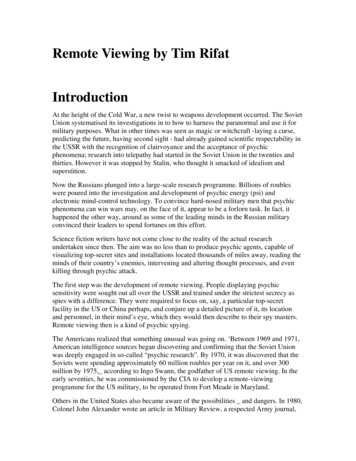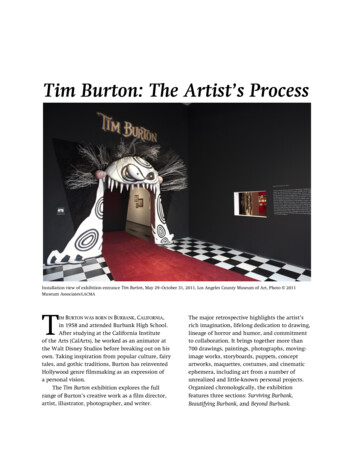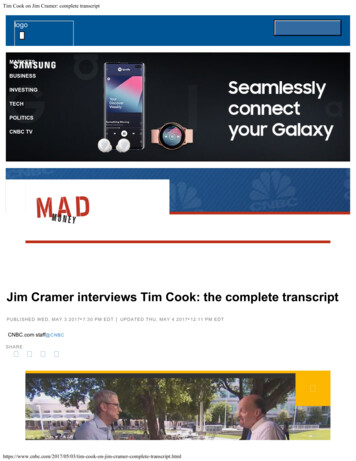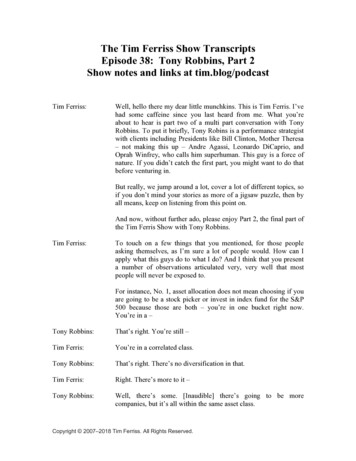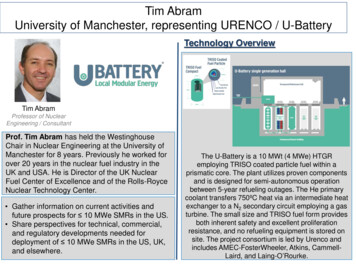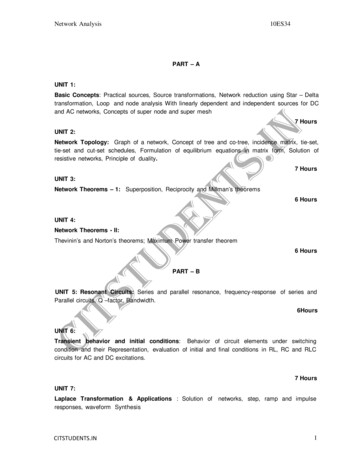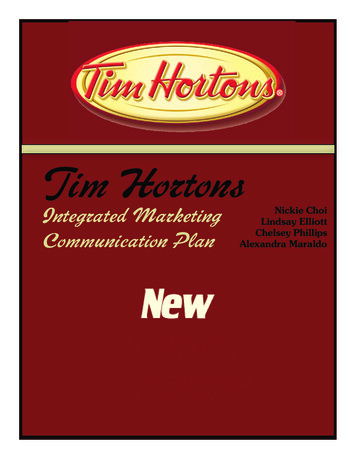
Transcription
Tim HortonsIntegrated MarketingCommunication PlanNickie ChoiLindsay ElliottChelsey PhillipsAlexandra Maraldo
Table of ContentsExecutive Summary.Page 1Tim Hortons as a Corporation.Page 2Overview of Corporation.Page 3Brand Review.Page 6SWOT Analysis.Page 7Market Positioning.Page 10IMC Objectives.Page 10Creative Strategy.Page 11Media Recommendations.Page 13Campaign Flowchart.Page 15Budgets.Page 16Conclusion.Page 20Appendices.Page 21References.Page 24
-1-Executive SummaryTim Hortons is known to be the “largest quickservice restaurant chain in Canada specializing inalways fresh coffee, baked goods and homestylelunches” (Tim Hortons, 2012). Their menuprovides a variety of selections including bakedgoods (such as cookies, muffins and donuts),bagels, soups, and sandwiches. There is, however,a very prominent gap in the products availablefor vegetarians despite present attempts to maketheir products accessible to vegetarians (such asproviding soups or foods cooked in vegetable oil,as outlined in Appendix A). They do have productsthat are not typically seen on their in-store menuboards such as the grilled vegetable sandwich(garden vegetable light cream cheese, cucumber,tomato and lettuce) and the grilled cheesepanini. Yet after these under-advertised products,options for vegetarian guests at Tim Hortons arerelatively few, especially in the hot food category.The purpose of this Integrated MarketingCommunication Plan (IMC) is to examine the TimHortons chain and provide suggestions for futuremarketing and branding possibilities. This planwill focus on alleviating this gap by introducingand marketing vegetarian friendly meal options.Tim Horton’s Mission Statement“Our guiding mission is to deliver superior quality products and services for ourguests and communities through leadership, innovation and partnerships. Our visionis to be the quality leader in everything we do” (Tim Hortons, 2012).The essential proposal is to introduce three new menu options: vegetarian lasagna,vegetarian chili and a grilled vegetable panini. Through a healthy eating campaignentitled, “New Veggie Choices” to maintain the Tim Hortons marketing approach, thiscampaign will run six months from July to November throughout Ontario. This will bea test region to study how the product is received before becoming national. The grilledvegetable panini campaign and product will be launched in May as part of a “SummerSandwiches” campaign. The launch for the chili and lasagna will begin in Septemberas the seasons begin to change, with the campaign coming to completion in November.
-2These products will be launched to run alongside the product already available inorder to disrupt the already successful Tim Hortons practices as little as possible. Thevegetarian chili will be pre-packaged just like the already existing chili (which consistsof ground beef, kidney beans, tomato, mushroom, green peppers, onion and celery (TimHortons, 2012) with the exception of it being meatless. The absence of meat will bereplaced by additional kidney beans and lentils. The same will be done for the lasagna(which consists of tomato sauce, ground beef, lasagna noodles, ricotta cheese, basil,oregano and garlic (CNW Group Ltd. , 2013)) and will be substituted with an eggplantoption. The final menu option proposal, a grilled vegetable panini, would be served onwhite or whole wheat gluten free bread with tomatoes, peppers, goat cheese and eggplant.These will be marketed in a numberof ways that will be discussed throughoutthis report. In order to gain publicity forthis product, we will capitalize on theTim Hortons branding. Using the in-storetelevisions and menu boards we can easilyincorporate a simple picture ad to placeon the screens to gain the attention ofalready loyal Tim Hortons customers aswell as placing ads on the Tim Hortonswebsite. We also plan to use newspaper adsas well as radio ads in order to make thebest use of the allotted budget given to us.The major challenges that may befaced consist of the implementation of theproduct and practise to stores, competingwith other companies who also carryvegetarian options, ensuring the productsells, working within the budget andof course ensuring that we are meetingthe gaps needs. This plan will discussthese challenges in full and providesuggestions on how best to n,thisIntegratedMarketing Communication Plan (IMC) willfurther examine the existing menu gap forvegetarians, elaborate on the suggestedmethods of eliminating these gaps andwill provide a structured marketing plan.It will address the objectives, the creativestrategies, the media recommendationsand will provide a thorough budget andexplanation on how this product will bemarketed. Upon completion, this plan willhave demonstrated how Tim Hortons canfurther its “Always Fresh” branding andcontinue to reach its marketing objectives.On behalf of our company, Chalinix, welook forward to working with you and creatinga successful and long-lasting partnership.
-3-Overview of CorporationThe Tim Hortons chain is a proud Canadian company that is known for its “ top quality, always fresh product, value, great service and community leadership ”(Tim Hortons, 2012). They started out in 1964 as a small chain specializing in coffee,baked goods and “homestyle lunches” from Hamilton, Ontario that quickly expandedinto a national trademark (Tim Hortons, 2012). In 1995, Tim Hortons teamed upwith Wendy’s International, Inc., which allowed it to not only grow as a companywithin Canada but also allowed it to begin expansion into the United States. By1995 there were 3,000 stores across Canada and 600 locations within the UnitedStates (Tim Hortons, 2012). By March 2006 Tim Hortons had made the decision toseparate and become a publicly traded company. On September 29th, 2006 it openedits shares to the public and is now traded on the NYSE and TSX (Tim Hortons, 2012).Competitive AnalysisTim Hortons faces a very large variety ofcompetition, not only with other companies thatspecialize in coffee, but as well “all restaurantsin the Quick Service category (burgers, subs,pizza, and so on” (Tim Hortons, 2012). Not onlywill it be competing against these markets,but as well any restaurants or establishmentsthat boast a healthy selection or cater directlytowards the vegetarian market will be in directcompetition of the Tim Hortons “New VeggieChoices” campaign. Such companies possiblyconsist of Subway, Extreme Pita, Culturesand Freshii (especially in the mall districts).One of the challenger companies that Tim Hortons will face the most competition may beMcDonalds. They are currently changing their image to encourage a dine-in atmosphere withhealthy options such smoothies and salads, as well as vegetable wraps directed at vegetariansand meat-free options (McDonald’s, 2013). Specifically, on August 27th 2013 McDonald’sdelivered a press release entitled, ‘Veggies? Canadians Asked. McDonald’s Listened’. McDonald’sintroduced two new meatless meals: the new Signature McWrap Mediterranean Veggie andSanta Fe Veggie Wrap (McDonald’s, 2013). It would be advisable that Tim Hortons begins tomarket their competitive products so that the competition does not continue to get ahead.
-4Environmental ResponsibilityIn keeping with trends, more and more consumers are holding companies accountablefor being socially and environmentally responsible in the way they conduct business.Restaurants such as McDonald’s practice corporate social responsibility by havingprograms that support sustainable land, anti-litter and waste reduction campaigns and openforums to encourage honest communication between themselves and their consumers.Tim Hortons competes with this by employing various forms of corporate socialresponsibility. Inside their restaurants they offer their customers the choice of chinadishware when customers are dining inside the establishment in order to cut downon waste. As an added incentive to cut down on waste, any refill done with the useof their Tim Hortons reusable mug is given a ten cent discount (Tim Hortons, 2012).Within their communities they are leading sponsors of community clean up events.As well, Tim Hortons is working hard to create a recyclable coffee cup. At themoment, their signature coffee cups are one of the most prominent types of litter that canbe seen in urban centres. The Tim Hortons website placed a statement on their websiteto support this: “We have anti-litter messages on all of our packaging items, includinga "Do Not Litter" message on all of our take-out cups. Sadly, many people do not payattention to these messages but we continue to work with other members of our industryto tackle the litter problem in a meaningful and effective way” (Tim Hortons, 2012). Inthis way, the Tim Hortons Corporation strives to not only compete in the environmentalawareness sector of business, but also works to gain community recognition for its efforts.Advertising and PromotionIn terms of advertising and promotion there are a number of methods that can beused. In the past, companies such as McDonald’s have relied on media mediums suchas radio, newspaper ads, billboards and sponsorship with the most prominent formbeing television. They also are heavily involved with social media, connecting theirdifferent platforms from their website (such as their Twitter account). Their website is amajor hub for their advertisements as it connects all of their press releases, nutritionalinformation, contact information, restaurant details and much more. They alsoincorporate competitions such as McDonald’s Monopoly to drive sales and advertising.In comparison, Tim Hortons also uses their social media such as Twitter andFacebook to drive their marketing. Games and competitions are also a factor intheir marketing campaign with the infamous ‘Roll Up The Rim To Win” campaign.Tim Hortons also uses sponsorships, television, radio and newspaper and print ads.
-5Buyer and Consumer AnalysisThe last couple of years have seen a drasticincrease in the markets of health and wellbeing products as well as those of vegetarian/healthy eating options. This is a prime timefor Tim Hortons to be capitalizing and joiningthis rising market. In 2003, 4% of Canadianadults followed a strictly vegetarian diet (927thousand out of a 23 million population).This number was estimated to show possiblegrowth of a further million people to follow thetrend. It is also expected that the market willdouble to a potential of well over 2.8 billion(Oliveira, Published 2004, Reviewed 2011).Healthy living and vegetarianism are two increasingly popular trends, as is noted byRoy Kingsmith, director of marketing for Yves Veggie Cuisine: “When this companystarted, probably 90 percent of our customers were true vegetarians, now it’s only10 percent vegetarians and 90 percent consumers who are simply looking for anoccasional ‘healthier’ meal” (Oliveira, Published 2004, Reviewed 2011). Therefore itis advantageous for Tim Hortons to market such a product at this time as it will reachmultiple market segmentations including vegetarians, those looking to cut back onmeat consumption and those simply looking for a variety in their healthy eating habits.
-6-Brand ReviewDescriptionKey Features/Benefits:We have chosen a three item “veggieoptions” addendum to the Tim Horton’smenu. The first of the items that we havechosen to launch is a grilled vegetable(tomato, pepper and eggplant) andgoat cheese Panini sandwich, whichwould be served on a choice of whiteor whole wheat bread. The seconditem is vegetarian lasagna made witheggplant in place of meat. Our finaladdition is a vegetarian chili optionwhich substitutes the meat in the originalrecipe with kidney beans and lentils.The key feature of our new menu items forTim Hortons are that they are vegetarian,which opens up our target audience byincluding both vegetarian and healthconsciousindividuals.Previously,vegetarian lunch/dinner options werelimited to their bagels and grilledcheese Panini, as well as the gardenveggie sandwich. This increased varietyalso appeals to existing Tim Hortonscustomers as it increases their choices.Place in IndustryWe believe that the addition of more vegetarian options will result in marketshare growth as it will be more appealing to a wider audience to include morehealth conscious and vegetarian individuals. We believe this will also improve TimHortons’ image as it will show that they are appealing to the healthy eating trend aswell as potential customer concerns about the availability of healthier alternatives.
-7-StrengthsWeaknesses Appealingtovegetariansand thatarenot Tre
Marketing Communication Plan (IMC) will further examine the existing menu gap for vegetarians, elaborate on the suggested methods of eliminating these gaps and will provide a structured marketing plan. It will address the objectives, the creative strategies, the media recommendations and will provide a thorough budget and explanation on how this product will be marketed. Upon completion, this .
